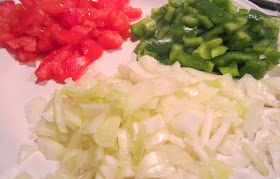Activities
While I helped my Mom with some Christmas shopping as well as doing some shopping on my own, Sophia prepared a delicious dinner.
She made guacamole dip...
seasoned meat for tacos or nachos (whichever a person preferred)...
and cut up tomatoes, green peppers, and onions...
She had shredded cheese and salsa to add to the toppings.
The cats were overly interested in the dinner. Lucy checked out Olivia's plate of food.
While Eenie checked out Sophia's tacos. Normally the cats don't sit on the table while we eat.
The girls wanted a picture with the cats sitting by them...so there they are...sitting with their feline friends.
*~*~*~*~*~*~*
Advent Reading
Luke 2:5-7 - He went to register with Mary, who was promised in marriage to him. She was pregnant, and while they were in Bethlehem, the time came for her to have her baby. She gave birth to her first son, wrapped him in cloths and laid him in a manger—there was no room for them to stay in the inn.
*~*~*~*~*~*~*
Christmas Joke
What’s red and white, and red and white, and red and white?
This is Santa in his sleigh with his fleet of reindeer.
Olivia made this back in 2010.
(Santa rolling down a hill!)
*~*~*~*~*~*~*
Christmas Fact
We learned about how giving Christmas cards became popular:
The custom of sending Christmas cards was started in the United Kingdom in 1843 by Sir Henry Cole. He was a civil servant (a government worker) who was very interested in the new "Public Post Office" and wondered how it could be used more by ordinary people.
Christmas stamp.
Sir Henry had the idea of Christmas cards with his friend John Horsley, who was an artist. They designed the first card and sold them for 1 shilling each. (That is only about 8 cents today, but in those days it was worth much more.)
The card had three panels. The outer two panels showed people caring for the poor and in the center panel was a family having a large Christmas dinner. Some people didn't like the card because it showed a child being given a glass of wine.
As printing methods improved, Christmas cards became more popular and were produced in large numbers from about 1860. In 1870, the cost of sending a post card, and also Christmas cards, dropped to half a penny. This meant even more people were able to send cards.
My first embossed Christmas card that I made in the 1980s
when I worked at an arts organization.
By the early 1900s, the custom had spread over Europe and had become especially popular in Germany.
The first cards usually had pictures of the Nativity scene on them. In late Victorian times, robins (an English bird) and snow-scenes became popular.
Christmas Cards appeared in the United States in the late 1840s, but were very expensive and most people couldn't afford them. It 1875, Louis Prang, a printer who was originally from Germany but who had worked on early cards in the United Kingdom, started mass producing cards so more people could afford to buy them. Mr Prang's first cards featured flowers, plants, and children.
In 1915, John C. Hall and two of his brothers created Hallmark Cards, who are still one of the biggest card makers today.
In the 1910s and 1920s, home made cards became popular. They were often unusual shapes and had things such as foil and ribbon on them. These were usually too delicate to send through the mail and were given by hand.
A trio of handmade Christmas postcards that I made.
Nowadays, cards have all sorts of pictures on them: jokes, winter pictures, Santa Claus, or romantic scenes of life in past times.
Charities also make money from seals or stickers used to seal the envelopes. This custom started in Denmark in the early 1900s by a postal worker who thought it would be a good way for charities to raise money, as well as making the cards more decorative.
It was a great success: over four million were sold in the first year! Soon Sweden and Norway adopted the custom and then it spread all over Europe and to America.






Enjoying your "countdown" I'm doing a similar thing on facebook (check it out here:
ReplyDeletehttp://adventuresintheballpark.blogspot.com/ )
I love the Christmas jokes! And all the crafts. I love crafting too. You're doing some beautiful things. Have a blessed Christmas!